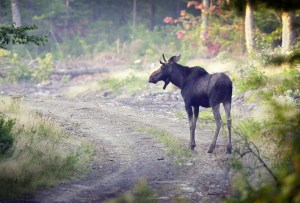RANGELEY — Moose numbers in the Rangeley to Stratton area are up this year, based on observations by participants in Saddleback Ski Resort‘s free moose watching tours.
Moose watching, a popular form of wildlife recreation in western Maine, provides excellent photographic opportunities and is a fun family activity, Kara Wilson, of the ski hill’s Guest Service Center, stated Tuesday in a report.
“We’ve been seeing a record number of moose on our tours this year, frequently eight each night,” Wilson said of the twice-a-week trips during the summer. “We’ve also seen baby moose, foxes and deer.”
Saddleback moose tours are free for all locals and guests visiting the Rangeley area. Trips leave on Monday and Thursday evenings typically around 7:15 p.m. on the Saddleback Shuttle from the resort’s guest service center on Main Street in Rangeley.
Times, however, change as daylight wanes later into summer.
Wilson said the moose tour follows Route 16 — locally known as “moose alley” — between Rangeley and the Eustis-Stratton area.
Depending on the number of moose seen each night, Wilson said tours last about 90 minutes.
“The tours are a great way for people to see Maine’s wildlife up close, and Saddleback is pleased to provide this free tour,” she said.
For reservations, which are required, contact the guest service center at 864-5496.
On the upper end of moose alley, Sugarloaf Ski Resort in Carrabassett Valley also offers moose viewing tours every Monday evening. But unlike Saddleback, Sugarloaf charges $20 a person.
They also limit moose cruise groups to four to 12 people, although special bookings for groups are available, spokesman Ethan Austin said Tuesday afternoon.
Local moose expert Ron Boudreau, a lifelong Maine resident who has been tracking and studying moose in the Sugarloaf area for years, is the moose cruise tour leader.
Sugarloaf boasts on its guided adventures program moose cruise website that Boudreau has only returned home once without seeing a moose in three years of leading the weekly moose cruises.
Moose cruise tours may last a few hours, depending on how long it takes to find moose, Austin said.
In addition to driving moose alley, Austin said Boudreau takes participants to a couple of other moose watching locations north of Stratton and in and around Eustis.
State moose biologist leader Lee Kantar of the Maine Department of Inland Fisheries and Wildlife said Tuesday afternoon that the Rangeley-Eustis area’s moose populations are “probably pretty stable.”
But that isn’t the chief reason why more moose are being seen. He said there are a variety of factors that bring moose out to roadsides in July and August.
“Moose sightings have a lot to do with seasonality,” Kantar said.
During late spring, they crave sodium from winter salting of roads that leeches into plants and pools along roadsides.
In the summer, their diet switches to aquatic plants, driving them into ponds and wetlands, which also allows them to cool off and avoid those pesky moose and deer flies.
Additionally, Kantar said moose cows with calves nurse them less during summer months, becoming much more mobile in foraging during the end of July and into August.
“Moose are highly sensitive to temperature, so even when it hits the 60s, they are being stressed by the heat,” Kantar said. “So in the daytime they seek shade or wetlands to cool down their bodies.”
Thunderstorms also help provide cooling.
As for moose watching, Kantar said the department long ago realized the importance of this particular wildlife recreation activity.
Not only do state wildlife biologists manage Maine’s moose herd for hunting, but they also have to strike a balance to keep plenty of moose available for people to view and enjoy.
“Rangeley is a very strong advocate to have moose available to view,” Kantar said.
However, he stressed that people need to keep a distance while viewing wild animals and moose, which have a healthy respect for people.
“There’s obviously a line in the sand — or a line in the mud — and moose will respond to that very aggressively, especially during times of heat stress,” he said.
When that line is crossed, moose will react abruptly, whether by returning to the woods or charging the offending person or group.
“If you start to change moose behavior in any way, you’re too close,” Kantar said.

Comments are no longer available on this story